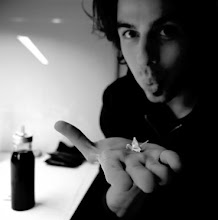Paris exhibits graffiti under polemics in Tag au Grand Palais

"It was fashionable a few years ago to dismiss Paris as a creative backwater. The real avant-garde was to be found in the happening cities of New York and London. The art pendulum has been swinging back for some time and it has been given another shove this weekend.
The venue is the Grand Palais, the monumental exhibition hall just off the Champs Elysées that is home to one of the top state galleries and where the Yves Saint Laurent art collection was auctioned last month. The new show is one of the world's most ambitious exhibitions of graffiti.
This is another case of French paradox since the state that is staging the exhibition is the same one that spends tens of millions of tax euros a year prosecuting and cleaning up after vandals who deface public property with their art.
Of course the contemporary art world has long seen the creative side of daubing trains and public spaces. A few stars of the underground, such as the late New Yorkers Keith Haring and Jean-Michel Basquiat, are revered as geniuses. Since the 1980s, the French Culture Ministry has also flirted with the graffiti, rap and dances of the hip-hop underground.
But eyebrows, including some artistic ones, have been raised by the consecration that the state has bestowed on the genre with its show of 300 specially commissioned oeuvres by international maîtres de l'art de la rue.
In Tag au Grand Palais, canvases by Snake131, a New York veteran, Nasty of Switzerland, Psyckoze of Paris and other eminent taggeurs, are hanging in a long-disused, tunnel-like gallery that runs along the side of the palace's great steel dome. The show is impressive in its scale. Some of the canvases are obviously clever and of quality, but to my sceptical eye, much of it looks like the daubing that pollutes urban life.
I had an interesting chat there with Toxic, a Bronx-born master of the genre, but first the complaints. Some in the artistic establishment say that l'Etat Français has gone too far this time by endorsing the American-inspired vandalism which blights the Métro trains, railways and housing estates of France.
"The state is punishing these people on one side and welcoming them on the other," Jean-Philippe Domecq, a writer and contemporary art specialist, told Le Point magazine. "This is subsidizing subversion." The state is so afraid of "missing another Van Gogh" that it throws money at every fad, he added.
Barbed praise for the show came from Pierre Cornette de Saint-Cyr, a leading auctioneer and President of the Association of the Palais de Tokyo, the contemporary art centre opposite the Eiffel Tower. "Ninety-nine percent of taggers are cretins who only want to foul walls," he said. He lamented the graffiti that adorned his museum's outdoor statues and hoped that the Grand Palais show would at least "distinguish between the artists and les cons (a___holes in American)."
The irony of the show is not lost on the distinguished spray-can bandits who were invited by Alain Dominique Galliz, an architect-collector [picture below], to come to his workshop in the Paris suburb of Boulogne from 2006-8. They were each paid to produce two panels, resembling the side of an underground train, one with their signature tags, or initials, and the other on the theme of love. In return, Galliz agreed not to sell their works and to show them together.

Bando, one of big French names, said that he was amused by the invitation to the Grand Palais. "Our work is usually on monuments, not inside them," he told Libération. RCF1, a Paris artist, said that Cornette de Saint Cyr knew nothing about graffiti since he had never been on the Métro. The artist knew this because he had been sentenced to community service work as a guard at Cornette de Saint Cyr's art centre after being convicted for committing graffiti.
Toxic, 43, whose work sells for large sums, told me that he admired Galliz for assembling artists who represent the four decades since modern graffiti first appeared in the US urban ghettos. He was amazed that his fellow practitioners had agreed to the French invitation. "It's not easy dealing with these guys. There have been a lot of fights. Like when someone else paints on your tag. Grudges are held forever."

It is not clear whether the police would be visiting the show to help them with their aggressive campaign against the graff-artists who cost so much in what might be considered a sort of "subsidy". For the past eight years, prosecutors have been pursuing not just perpetrators, but also taking action against internet sites and art magazines for aiding and abetting criminals.
Toxic, who now lives in Italy, recalled that British police had visited a London gallery where he had shown his work. "They were there to see your face and arrest you." He recognised an ethical dilemma but said that he continued to keep his hand in on subway trains and tunnels, leaving his fresh oeuvres with other initials. "I try not to do it too much because I visit schools. I tell the kids to be careful because they could be arrested."
Gallizia has been defending his project. "This is not about ugly scribbling, but well and truly genuine works of illumination and calligraphy," he said. "Even if this form of expression is sometimes violent and aggressive, there is a fraternity behind it."
The show is worth a visit if you're in Paris, if only for the novelty of its setting."
De Times On-line. Para ver la fuente original clica aquí.
Posts Relacionados:
Exposicion Miscelanea para Dj's Contra la Fam: Spray contra la Fam



No hay comentarios:
Publicar un comentario